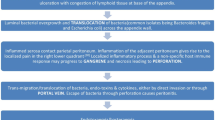Abstract
Acute appendicitis is one of the commonest causes for acute abdomen that requires surgical treatment. It may cause dire complications like ruptured or gangrenous appendicitis [RGA]. This study was aimed to find whether serum total bilirubin [STB] can be used as a new pre-operative laboratory marker to aid in the diagnosis of RGA in acute appendicitis and also to find the significance if any for RIPASA and modified Alvarado scoring system [MASS] in the same. This was a case series analysis in 150 patients admitted with right iliac fossa [RIF] pain. MASS and RIPASA scores were given and STB investigated for all patients. Further treatment was planned according to the surgeon’s discretion taking into consideration the RIPASA scoring category of each patient. Post-operatively all appendix specimen were send for histopathological examination (HPE). Intra-operative diagnosis and post-operative HPE reports were taken to diagnose RGA. Further the STB values were correlated with occurrence of RGA to find any statistically significant relation between hyperbilirubinemia and RGA. A total of 150 patients were analyzed on accrual and mean STB value 1.20 mg/dl SD1.50. The mean STB values of 121 patients who were diagnosed to have appendicitis were 1.36 mg/dl SD1.62. Of these, 33 had RGA, while 88 did not. The STB values of the patients with acute appendicitis and not RGA had a mean value of 0.61 mg/dl SD0.34, while patients with RGA had a mean value of 3.37 mg/dl SD1.95. According to the present study, a STB value above 1.75 mg/dl in a patient with RIF pain has high probability to have RGA. RIPASA and MASS values could not be significantly correlated with RGA, thereby increasing the importance of serum total bilirubin as a new pre-operative laboratory marker to aid in the early diagnosis of ruptured or gangrenous appendicitis in acute appendicitis.


Similar content being viewed by others
Abbreviations
- RGA:
-
Ruptured and gangrenous appendicitis
- USG:
-
Ultrasonography
- CECT:
-
Contrast-enhanced computed tomography
- RIPASA:
-
Raja Isteri Pengiran Anak Saleha Appendicitis
- MASS:
-
Modified Alvarado scoring system
- STB:
-
Serum total bilirubin
- RIF:
-
Right iliac fossa
- DA:
-
Definitive appendicitis
- HP:
-
High probability
- LP:
-
Low probability
- UL:
-
Unlikely
- HPE:
-
Histopathological examination
- NA:
-
Non-appendicitis
- IQR:
-
Interquartile range
- SD:
-
Standard deviation
- PPV:
-
Positive predictive value
- NPV:
-
Negative predictive value
- CRP:
-
C-reactive protein
References
Prystowsky JB, Pugh CM, Nagle AP (2005) Appendicitis. Curr Probl Surg 42(10):694–742
Ferris M, Quan S, Kaplan BS, Molodecky N, Ball CG, Chernoff GW, Bhala N, Ghosh S, Dixon E, Ng S, Kaplan GG (2017) The global incidence of appendicitis: a systematic review of population-based studies. Ann Surg 266(2):237–241
Chong CF, Thien A, Mackie AJ, Tin AS, Tripathi S, Ahmad MA, Tan LT, Ang SH, Telisinghe PU (2011) Comparison of RIPASA and Alvarado scores for the diagnosis of acute appendicitis. Singapore Med J 52(5):340
Kalan M, Talbot D, Cunliffe WJ, Rich A (1994) Evaluation of the modified Alvarado score in the diagnosis of acute appendicitis: a prospective study. Ann R Coll Surg Engl 76(6):418
Frountzas M, Stergios K, Kopsini D, Schizas D, Kontzoglou K, Toutouzas K (2018) Alvarado or RIPASA score for diagnosis of acute appendicitis? A meta-analysis of randomized trials. Int J Surg 56:307–314
Alvarado A (2018) Clinical approach in the diagnosis of acute appendicitis. Garbuzenko D. Current Issues in the Diagnostics and Treatment of Acute Appendicitis. Intech Open. 13–42
Bhogal HK, Sanyal AJ (2013) The molecular pathogenesis of cholestasis in sepsis. Front Biosci (Elite Ed) 5:87
Kakar M, Reinis A, Kroica J, Engelis A, Broks R, Asare L, Vermeulen M, Senica SO, Saxena A, Petersons A (2022) Microbiota assessment of pediatric simple and complex acute appendicitis. Medicina 58(9):1144
Skals M, Jorgensen NR, Leipziger J, Praetorius HA (2009) α-Hemolysin from Escherichia coli uses endogenous amplification through P2X receptor activation to induce hemolysis. Proc Natl Acad Sci 106(10):4030–4035
Hajivassiliou CA (2003) Intestinal obstruction in neonatal/pediatric surgery. InSeminars in pediatric surgery (Vol. 12, No. 4, pp. 241–253). WB Saunders
Akai M, Iwakawa K, Yasui Y, Yoshida Y, Kato T, Kitada K, Hamano R, Tokunaga N, Miyaso H, Tsunemitsu Y, Otsuka S (2019) Hyperbilirubinemia as a predictor of severity of acute appendicitis. J Int Med Res 47(8):3663–3669
Sand M, Bechara FG, Holland-Letz T, Sand D, Mehnert G, Mann B (2009) Diagnostic value of hyperbilirubinemia as a predictive factor for appendiceal perforation in acute appendicitis. Am J Surg 198(2):193–198
Farooqui W, Pommergaard HC, Burcharth J, Eriksen JR (2015) The diagnostic value of a panel of serological markers in acute appendicitis. Scandinavian J Surg 104(2):72–78
Pogorelić Z, Lukšić AM, Mihanović J, Đikić D, Balta V (2021) Hyperbilirubinemia as an indicator of perforated acute appendicitis in pediatric population: a prospective study. Surg Infect 22(10):1064–1071
Shuaib A, Alhamdan N, Arian H, Sallam MA, Shuaib A (2022) Hyperbilirubinemia and hyponatremia as predictors of complicated appendicitis. Med Sci 10(3):36
Author information
Authors and Affiliations
Corresponding author
Additional information
Publisher's Note
Springer Nature remains neutral with regard to jurisdictional claims in published maps and institutional affiliations.
Rights and permissions
Springer Nature or its licensor (e.g. a society or other partner) holds exclusive rights to this article under a publishing agreement with the author(s) or other rightsholder(s); author self-archiving of the accepted manuscript version of this article is solely governed by the terms of such publishing agreement and applicable law.
About this article
Cite this article
Shaji, B., Bhattacharjee, S.S. Role of Hyperbilirubinemia as a Predictor in case of Ruptured or Gangrenous Appendicitis. Indian J Surg 86, 89–93 (2024). https://doi.org/10.1007/s12262-023-03801-4
Received:
Accepted:
Published:
Issue Date:
DOI: https://doi.org/10.1007/s12262-023-03801-4




